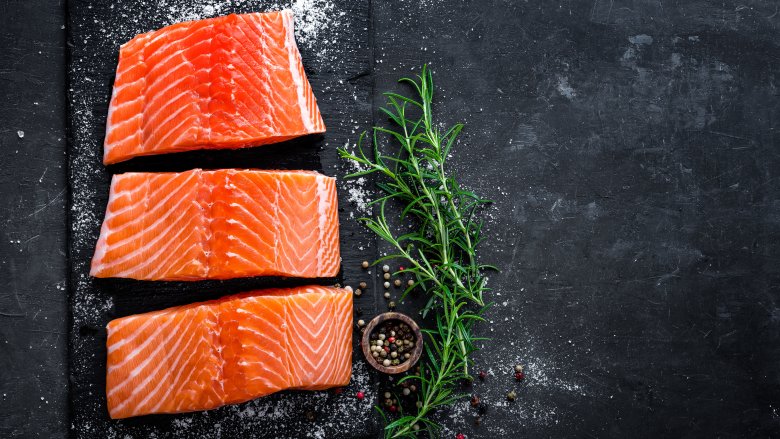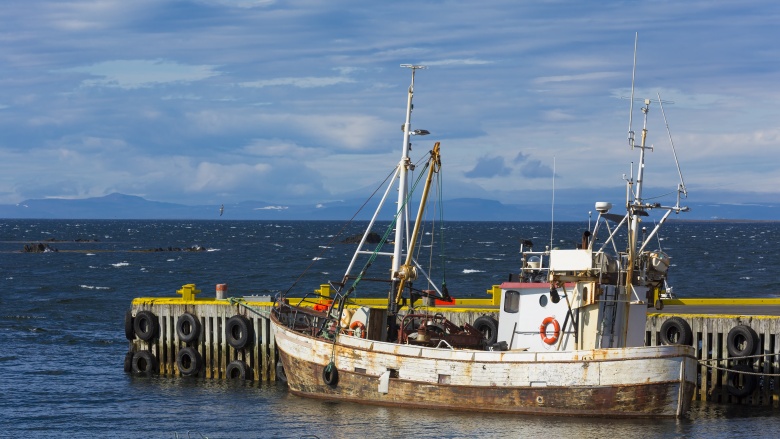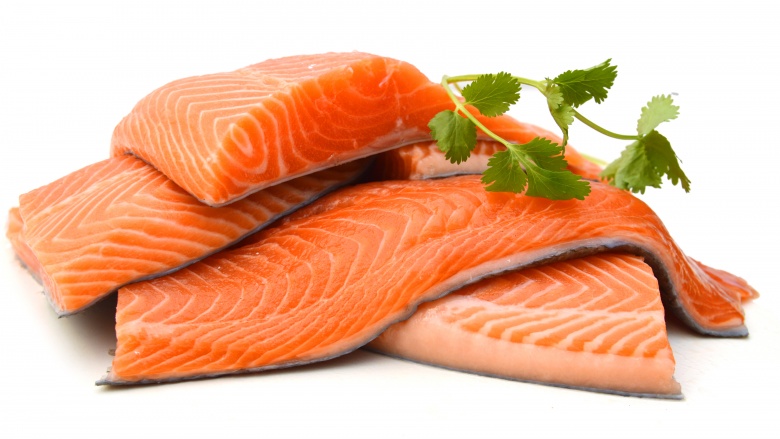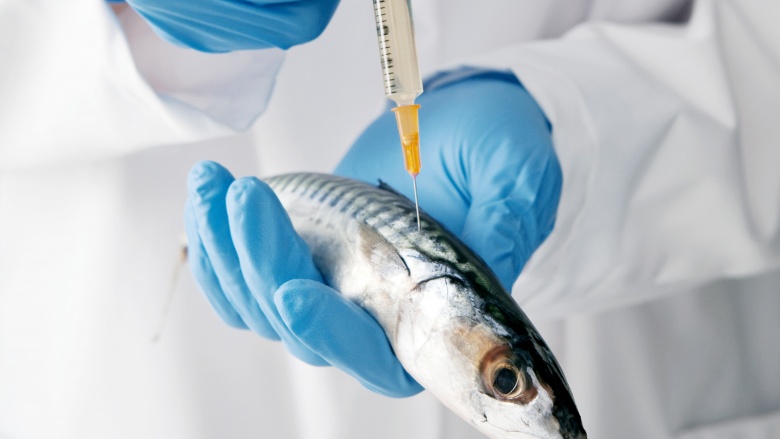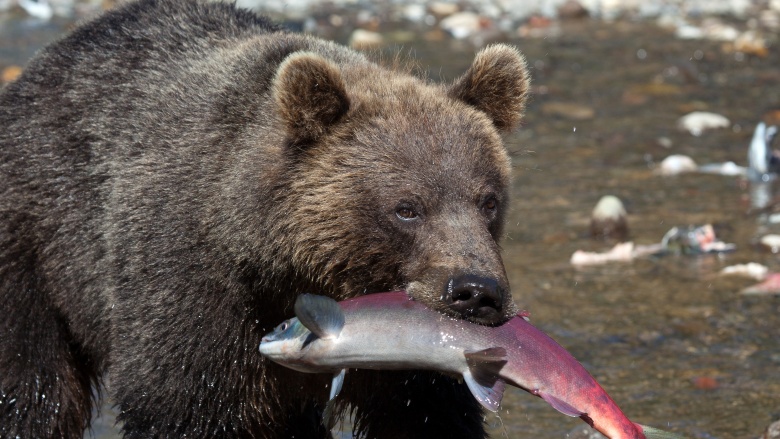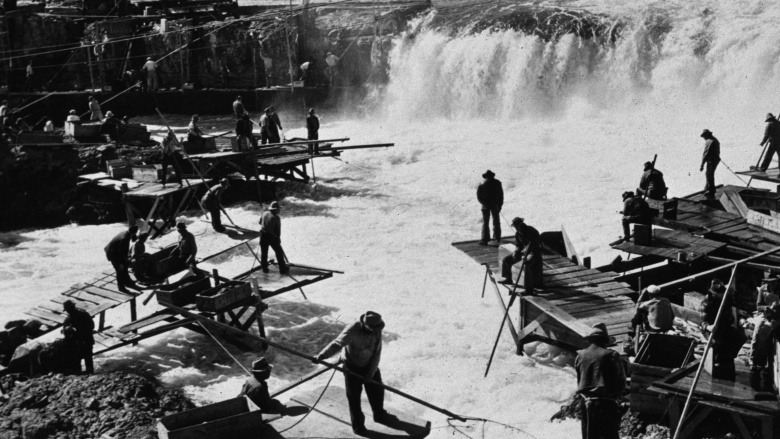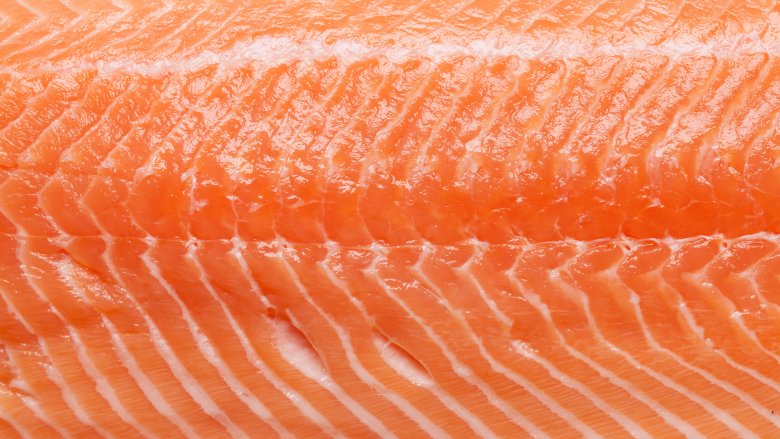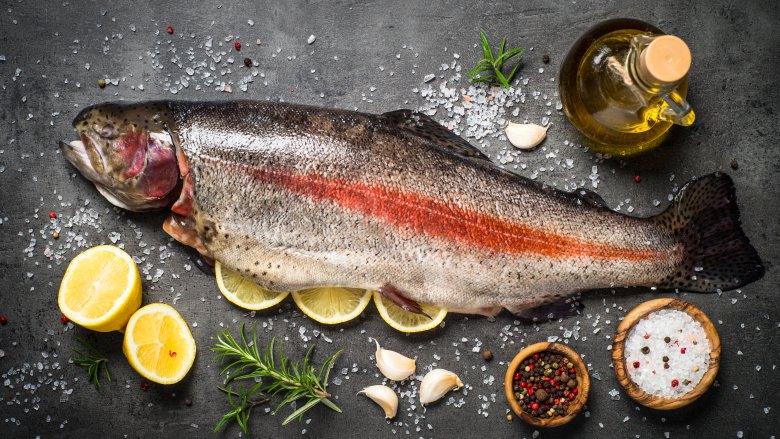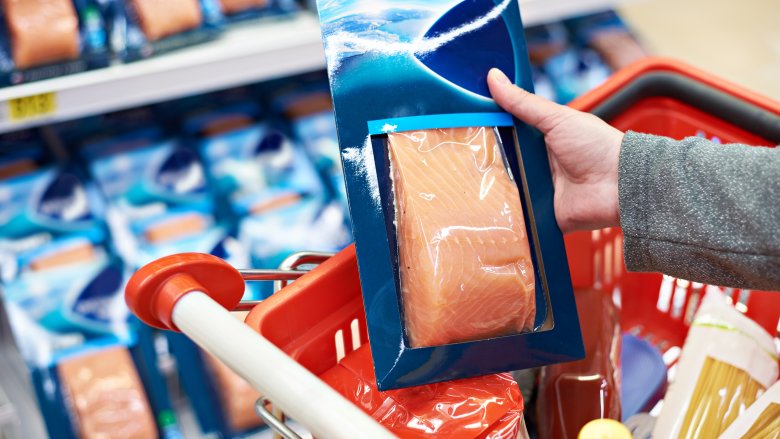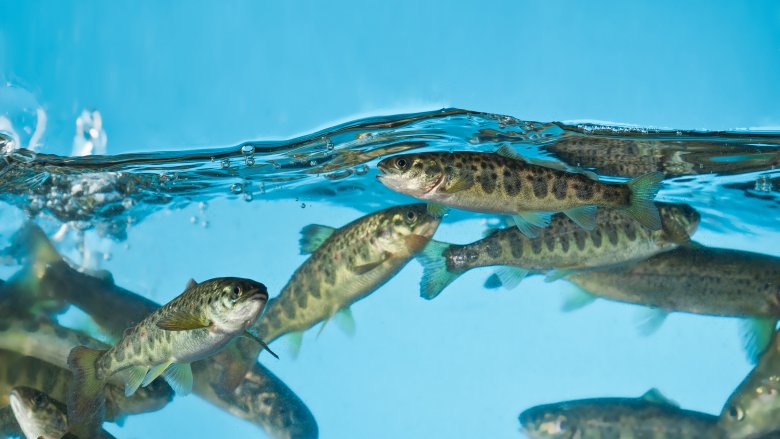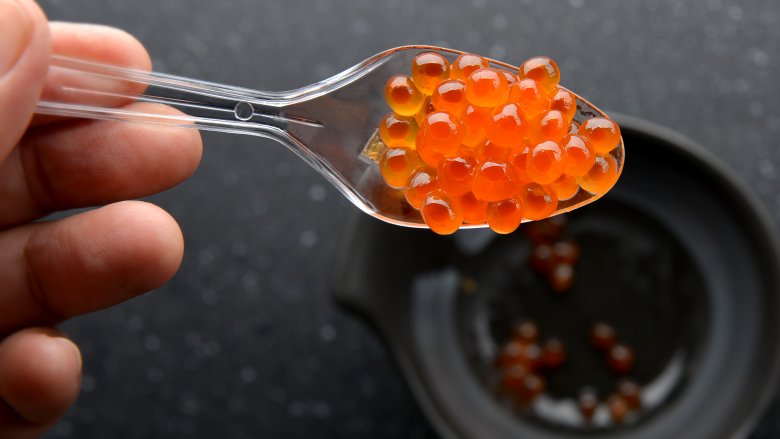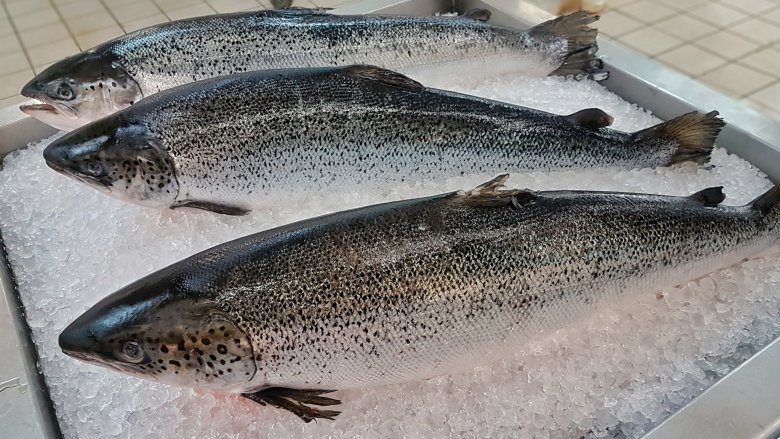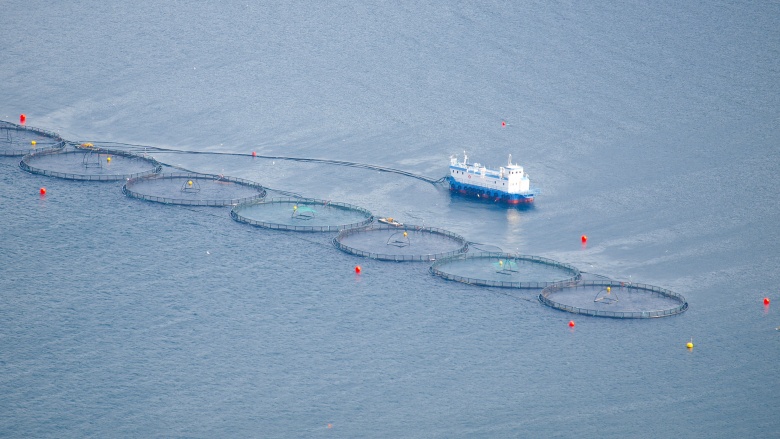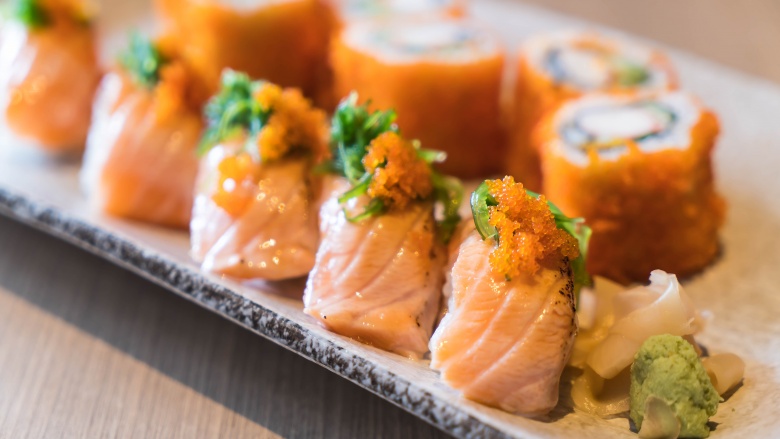The Truth About Salmon
We eat a lot of fish. Like... a lot of it. In 2018, the Joint Research Centre of the European Commission reported that globally, our fish consumption has more than doubled in the last 50 years. In fact, as of 2014, we were eating about 44 pounds per capita per year.
And when it comes to what we're eating, salmon is at the top of the list. According to the Delaware Sea Grant, salmon has been in the top three of America's favorite fishes for years. There's good reason for that, too. Not only are there a ton of different ways to make it delicious, but it's well-known just how nutritious it is. Plus, it's convenient — it's readily available as canned, fresh, or frozen.
And we're not the only ones who love it. According to the WWF, salmon is considered what's called a keystone species. That means they have a shockingly huge impact on their environment and ecosystems, and it's fascinating stuff. They're not just prey for a number of larger animals, but when they die in their natural habitat, they're responsible for carrying nutrients from the ocean to the land. Because science is pretty awesome, it's even allowed us to trace those nutrients, which can end up in everything from trees to bears and birds. Did you know salmon was so cool? There might be a lot you don't know about this fish, so read on.
There's more than one variety of salmon
Most of the salmon that we eat is conveniently named for the ocean or region it came from. Pacific salmon covers a range of popular salmon, including gourmet favorites chinook (king), and sockeye, as well as the less-pricey coho variety. Pacific pink salmon is the most popular choice for canneries, making it an economical choice when looking for wild salmon. This rule, however, doesn't necessarily apply to salmon labeled Atlantic salmon, which is a popular name for farmed salmon. When in doubt about salmon's origins, be sure to ask your fishmonger exactly where the salmon you're buying is coming from.
Salmon has plenty of beauty and health benefits
There is no wonder that Fitness named wild salmon a superfood for both skin and hair. Packed with selenium, salmon helps to naturally protect your skin from the sun's harmful rays. Salmon's high levels of omega-3s also help to keep your skin looking youthful and moisturized, not to mention omega-3's reputation for lowering the risk of heart disease, combating the joint pain of arthritis, and aiding conditions like depression, asthma, and ADHD.
A known anti-inflammatory, Omega-3s can even help prevent osteoporosis, according to researchers at Ohio State University, who observed that women with higher concentrations of the fatty acid in their bodies suffered fewer hip fractures.
Beware genetically modified salmon
In 2015, the FDA approved a genetically modified salmon created by a company called AquaBounty, as fit for human consumption. AquAdvantage, as the GMO salmon is called, contains a splice of genes, including the Pacific chinook salmon and a bottom-dweller fish known as an eelpout. The result, reportedly, is a salmon that grows larger and faster, requiring less feed than its farmed cousins. In 2016, lawsuits were filed against the FDA by a number of plaintiffs, who claim the FDA was negligent in overlooking the potential harm to wild salmon populations should the GMO fish hatch any escape plans, not to mention the detriment to fishing communities and the environment.
AquAdvantage is planned to be sold as Atlantic salmon, so if you're looking to avoid a dinner of Frankenfish, aim for wild salmon, or any salmon labeled as a Pacific variety.
Salmon's importance in nature
We all know that salmon does a body good, but did you know that it's also vital for the health of wildlife and ecosystems? Grizzly bears of Alaska and the Pacific Northwest not only feast on salmon for nutrition, but they also carry the carcasses to the forest floor, leaving behind valuable phosphorus, carbon, sulfur and nitrogen. Scientists have even found nitrogen that originated from salmon in the leaves of spruce trees located more than 1,600 feet from streams where Grizzlies fish for salmon.
Beavers also enjoy a healthy relationship with salmon — a beaver's dam can provide a habitat for young salmon, and shield the juveniles from the dangers of avian predators above.
Salmon's cultural significance
For the Native American tribes residing in the Pacific Northwest's Columbia Basin, salmon plays far more importance in their culture than just sustenance. For these "Wy-Kan-Ush-Pum," or "Salmon People," the salmon is sacred, guiding not only their diets, but also their religion, culture, livelihoods, and entire society. According to tribal legend, the Creator gave the people the gifts of salmon and water on the first day, and salmon continues to play a central role in religious and cultural ceremonies and celebrations.
When the 1960s brought a sharp decline in salmon harvests, the tribes fought back against overfishing and pollution by sending many youth to study environmental engineering, fish biology, and law. That way, they may still preserve their traditional way of life.
There have been a number of disturbing reports about salmon
It's no secret that salmon is good for you, but there's a catch: If it's not properly prepared and cooked to the right temperature, there's a chance some salmon can be deadly... or, at the very least, super disgusting.
In 2017, CNN reported that salmon caught off the coast of Alaska were found to be carrying a type of Japanese tapeworm thought to only infect fish in Asia. Researchers said it was likely that the worms could be found in any salmon caught along the Pacific coast, and since they survive while being exported on ice, the larvae can show up in salmon anywhere in the world.
And yes, people who eat them can become infected. Treatment, they stress, is usually simple and effective, but that's the sort of thing that ruins, well, everything.
That's not the only thing that salmon has been found to carry and spread, either. In 2008, the UK's Food Standards Agency warned (via The Telegraph) that any salmon caught in Britain could be carrying the herring worm parasite, which was potentially deadly. The NHS continues to carry warnings about the parasites found in wild salmon, and stresses that proper cooking or freezing is necessary to ensure larvae are killed. In order to kill the Japanese tapeworms, for example, you'll need to cook the fish to 145 degrees for up to five minutes, meaning that rare center probably isn't in the cards if you're not interested in consuming larvae.
Salmon is responsible for a shocking amount of pollution
Salmon farms are huge, and they're basically massive sections of the ocean set aside for large clusters of fish. According to the Watershed Watch, though, anything that's used in raising farmed salmon freely passes into the surrounding waters, and that's a big problem.
Chemicals used to treat farmed salmon include antibiotics, disinfectants, and antifoulants, many of which are necessary to keep farmed salmon healthy and — particularly — treat common infestations of sea lice. While there hasn't been much research done on just how these chemicals impact wild marine life, studies have shown that contaminants from salmon farms can cause elevated levels of mercury in nearby wildlife.
The Guardian described salmon farming as "a chemical arms race in the seas," and in 2019 they reported that Scotland had made a deal with their salmon farmers. They were lifting restrictions on the size of farms, but in return, farmers were going to have to agree to much, much stricter regulations limiting the pollution that would be dumped into surrounding waters. Is it too little, too late? Or precedent-setting?
You might be buying mislabeled salmon
In late 2018, New York's state attorney general's office released a report detailing just how badly labeled the state's seafood is. According to Quartz, one in every four supermarket samples weren't what the labels said they were and yes, that goes for salmon, too. It was found that "28 percent of 'wild' salmon was actually farmed salmon, despite costing one-third more on average."
A more extensive, nationwide study done by Oceana found that one in every three seafood samples were mislabeled. You might think that salmon's distinctive look would keep it from being misrepresented, but they say that it's one of the common occurrences of bait-and-switch. Many times, the salmon labeled as either wild, king, or sockeye was actually farmed Atlantic salmon.
It's been happening for a while now. In 2015, Oceana reported that out of 82 salmon samples they collected from the 2013-2014 season, 43 were mislabeled. That wasn't just terrible, it meant the mislabeling of salmon was on the rise. Two years earlier, they found only 7 percent of salmon was mislabeled.
And according to New Scientist, part of the problem is, shall we say, creative naming. If you see rock salmon on the menu, for example, would you buy it thinking it's a type of actual salmon? It's not — it's dogfish, and those are a type of shark subject to overfishing.
Farmed salmon could destroy wild populations
Farmed salmon is worrying for a number of reasons, and according to Watershed Watch, one of those reasons is salmons' tendency to escape their farms. They're typically kept in net cages, and whether it's a consequence of human error or weather, a single malfunction can release tens of thousands of farmed fish into the environment. (It happens on a small scale all the time, and it's called leakage.)
When that happens, they don't just spread disease and parasites, they compete with native populations for resources. They also breed with those native populations and, over time, that results in damage to the natural biodiversity. Monterey Bay Aquarium's Seafood Watch says that since farmed species are genetically different than wild ones, the offspring that results from interbreeding is less capable of surviving in the wild, and essentially, farmed salmon becomes a destructive, invasive species.
How many fish are we talking about? Enough to worry about. In 2018, Modern Farmer reported on just one incident where between 2,000 to 3,000 farmed salmon escaped in Newfoundland, and that's just the official numbers given by the farm. At the end of 2017, that pen was actually home to 75,000 fish.
Salmon are being engineered to be sterile
The debate over GMOs is one that's unlikely to go away any time soon, but did you know that the practice of engineering our food has expanded to salmon?
Research done in 2013 as part of a collaboration between six aquaculture companies was, Science Nordic reports, trying to find a way of producing sterile salmon with a non-GMO method. How, exactly, does that work?
Original experiments involved subjecting the eggs to a high pressure environment, but the fish that resulted suffered from severe skeletal defects. From there, researchers tried diet modification and vaccinations that would stop the maturation process of the salmon at a certain point.
In 2017, Norweigan research group Nofima announced (via Fish Farming Expert) that they'd had a breakthrough, and found a method for altering a certain protein in the salmon to render them sterile. Work is ongoing: In 2018, The Fish Site reported on the start of a three-year project headed by the University of Iceland and Benchmark Genetics, all in hopes of developing a way to sterilize salmon on a commercial scale.
Why? To prevent cross-breeding between farmed salmon and wild populations.
Here's how to choose the best fresh salmon
If you're serious about your fish — or, if you want to start getting serious about it — you might head to a fishmonger or the fresh seafood counter of your area's trendiest grocery store. When you get there, you're going to want to know what you're looking for. So, how do you know you're picking the freshest, best salmon out of the lot?
Berkeley Wellness has some tips, and they say that one of the first things you're going to want to look for is to make sure there's no liquid pooling around the fish. It shouldn't smell fishy at all, and instead, you should get a mild, almost sweet odor. Then, touch the flesh. It should spring back immediately.
That flesh should also be shiny, with no dark spots or discoloration around the edges. The Columbia River Inter-Tribal Fish Commission says that's a sure sign that the fish is older than you'd like. The eyes should be clear (not cloudy), and the gills should be bright red.
And, in order to keep it fresh, you should make shopping for fish your last stop before heading home — preferably to eat it that night. You should also plan on bringing along a cooler filled with ice to keep your fish from starting to go off, because there's nothing that'll ruin your day — or your dinner plans — faster than that.
What to know about farmed salmon vs. wild salmon
It's perhaps the most puzzling question for salmon lovers: which salmon to buy, farmed or wild? While farmed salmon will certainly save a few bucks at the store, wild salmon is going to deliver much more for your buck in terms of not only flavor, but more importantly, in nutrients. Wild salmon contains higher levels of potassium, zinc, iron, and calcium, but comes with less fat and calories than an equal serving of farmed salmon. While both contain high levels of heart-and-brain-healthy Omega-3's, science shows those in farmed salmon to be of lesser quality. Farmed salmon also needs help to develop that deep pink color that most wild salmon naturally has due to it's diet — chances are, the farmed salmon you purchase has been fed supplements, or even dyes, to obtain that hue.
Salmon farmers have heard the concerns, however, with many producers seeking ways to make farmed salmon as healthy and sustainable as possible (Whole Foods' Quality Standards for Aquaculture program strives for a very high-quality farmed fish.) At the end of the day, both wild and farmed salmon are a healthy choice, with both helping you to achieve the two servings of oily fish per week recommended by the USDA. Just aim to buy the best quality salmon that you can find and afford.
So many ways to enjoy salmon
Popular in a wide range of cuisines, there's no shortage of ways to prepare and enjoy a delicious salmon meal. Smoked salmon, lox, and gravlax are preparations that involve no cooking at all — the fish is cured and brined over time, creating delicacies long enjoyed in Jewish and Scandinavian cuisines. Raw salmon, in the form of sushi or sashimi, is one of the top sellers in sushi restaurants worldwide.
For the home cook, fresh or frozen salmon fillets and steaks are readily available, with salmon's meaty texture standing up well to the stovetop, oven, or grill. Canned salmon is also a home cook's friend — simply mix some canned wild salmon with bread crumbs, minced veggies, and herbs, form into patties, and fry them up in a well-oiled pan for a gourmet salmon cake dinner in a snap.
